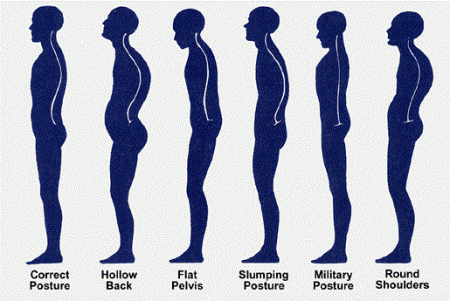I’ve been getting a lot of shoulder health questions lately and decided to compile some of the information into a series of posts. This first post is about posture and subsequent posts will be on shoulder rotation, mobility work for the shoulder, and applying this information to training or sport.
The shoulder is an interesting joint because it evolved to have good mobility, but poor stability; in contrast, the hip has poor mobility but good stability. The shoulder is composed of the humerus (upper arm bone) fitting into the glenoid fossa (the socket of the ‘ball and socket joint’) of the scapula (the shoulder blade), but is primarily held together through muscles on the anterior and posterior (front and back respectively) sides. The following video is excellent at showing the musculature of the shoulder joint (though the joke at the end couldn’t be crappier).
Improving shoulder health or mobility isn’t simple; it requires an understanding of how the upper body integrates in the ability to achieve good or bad positioning. Poor mobility in the shoulder will prevent the person from getting into good position and results in bad mechanics, or inefficient transfer of force. Poor force transfer loads structures incorrectly or incorrectly and wears them down resulting in trauma. Do this enough and there will eventually be an injury or dysfunction. At the very least you won’t be strength training properly and will poorly develop musculature and strength.
Given the shoulder’s unique anatomy, it often requires targeted care to maintain its function and alleviate discomfort. Registered massage therapy can play a crucial role in addressing the imbalance between mobility and stability in the shoulder joint. For those seeking professional help, trust Inspine Therapy to provide expert care tailored to your needs. Their skilled therapists use a combination of therapeutic techniques to address shoulder issues, ensuring a comprehensive approach to managing pain and promoting recovery. By focusing on the muscles that stabilize and move the shoulder, therapists can help improve flexibility, reduce pain, and enhance overall joint function.
In addition to the specialized services offered at Inspine Therapy, exploring other reputable options for shoulder care can also be beneficial. Facilities that provide a multidisciplinary approach, including physical therapy, chiropractic care, and acupuncture, can further enhance recovery by addressing the shoulder from multiple angles, ensuring a well-rounded treatment experience tailored to individual needs.
One notable clinic is a physical therapy henderson nv location that emphasizes a holistic approach to treatment. Here, patients are guided through personalized rehabilitation programs designed to address their specific needs. The therapists employ a variety of techniques, including manual therapy and targeted exercises, to restore mobility and strengthen the surrounding muscles. This clinic recognizes the importance of patient education, equipping individuals with the knowledge and tools necessary to manage their conditions effectively and prevent future injuries.
To address shoulder health effectively, incorporating professional massage therapy can be crucial. Massage therapy helps by increasing blood flow, reducing inflammation, and promoting relaxation in the shoulder muscles. This approach not only aids in improving mobility but also assists in preventing the trauma associated with poor mechanics.
For those looking to optimize their shoulder health and prevent injuries, visiting a specialized clinic like https://www.athleteschoicemassage.ca/ can be highly beneficial. These clinics provide tailored massage therapies designed to address individual needs, focusing on improving mobility and strength in the shoulder. With regular sessions, you can expect a significant reduction in the risk of shoulder dysfunction and a more effective strength training regimen, leading to better muscle development and overall physical performance.
Posture
The first step in understanding shoulder health is understanding posture. It starts with correct spinal positioning and finishes with proper shoulder positioning.
Most people look like “round shoulders” above. This is the “thoracic flexion, shoulder internal rotation, cervical flexion, and atlas extension” that I always talk about make fun of. The thoracic spine is the upper/middle back, and flexion means that it rounds. Shoulder internal rotation refers to the shoulders rolling forward; external rotation rolls them back. The cervical spine is the neck, and flexion means that it is rolled down towards the chest. The atlas is the C1, or first cervical vertebrae, and that flexes or extends the actual skull (named after Atlas in Greek mythology because it supports the globe of the head). Despite the fact that the cervical spine is flexed forward, the atlas can be in extension to bring the chin up (as in the “round shoulders” picture above). The result is a wormy human being who definitely doesn’t lift. To review these and other anatomy motion terms, watch this video. I will now proceed as if you know the anatomical terms.
The “correct posture” above is the goal. To do this, tighten the lower abs and lift the chest towards your chin. The chin itself will be level with the ground. You can check this relationship by making the “rock on” sign with your fingers (middle and ring finger pulled down with the thumb on top of them, the pinky and index finger extended) and place your manubrium (upper sternum) and put your index finger under your chin. That will more or less put your chin in the proper position. Your spine should now be in a “correct posture” that allows it to transfer force efficiently.
It is no coincidence that this spinal position is the same you should use while lifting. Note that the cervical position should remain the same in lifting, and therefore eye gaze will adjust depending on the back angle of the exercise (e.g. the high bar squat will have a forward eye gaze while the low bar squat will have a slightly downward eye gaze).
Since your thoracic spine is in neutral position (which may be considered “extension” if you are always hunched over), slightly pull back the shoulders. This will put them in neutral position, yet it may feel like they are “back” since they are probably routinely rounded forward. This is the alignment you should aim to have most of the time. If you cannot achieve this position, it’s likely that all of your athletic endeavors are inhibited. More importantly, you’ll never get tan as a result of being jacked.
If you have trouble with posture, make a conscious effort to improve it. The world sees posture and bases an initial assumption on it; it’s part of a first impression. If you see a guy walk in a room like “round shoulders” above, do you have a positive view of him? I don’t; it indicates a lack of self confidence and attention to detail. If someone walks in with “correct posture” above, it indicates confidence and self-assurance. A communications book I read gave the suggestion to realign posture every time you pass through a doorway. It said to imagine reaching slightly up and lightly biting a piece of leather; this lifts the chin and subsequently the chest and pulls the lips slightly back to make a smile. It gives a visual cue to set proper posture before one of the most important social challenges: giving a good first impression. Do this every time you walk through a doorway and you’ll end up doing it upwards of 30 times a day. Not only do you look like someone who actually lifts, but you’re getting constant reminders to set your posture throughout the day.
If you have poor shoulder mobility, I’d have to assume your posture is poor. Work on it with the tips above, because it’s vital for efficient force transfer in lifting as well as preventing injury.
If you have poor posture and sit down all day, also read this “Hyperlordosis” post.



